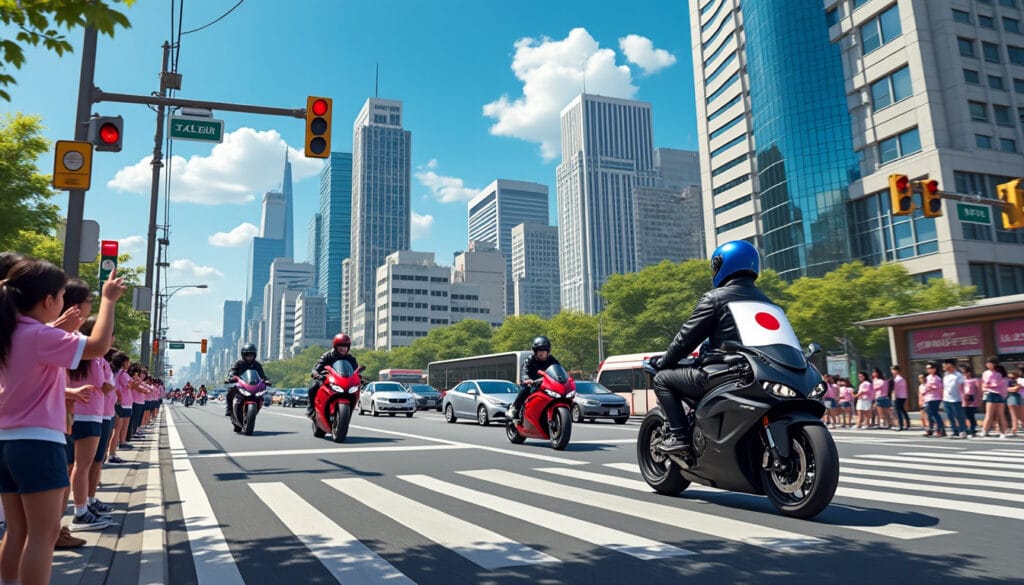traffic between lanes maintained until September!

While the practice of filtering traffic (CIF) is sparking lively discussions in the world of two-wheelers, the Road Safety authority recently announced the extension of its experimentation until September 14. This decision is particularly meaningful in light of the upcoming Olympic Games, with their consequences on traffic in the Île-de-France region. The implementation of "Olympic lanes" raises many questions about the current regulations for motorcyclists. In this article, we will explore the evolution of filtering traffic, the safety issues, and the implications of these new rules.
The challenges of filtering traffic in the current context
Filtering traffic is a practice already well entrenched in the habits of French motorcyclists. Its official recognition remains a sensitive topic that touches on road safety and the organization of traffic in highly congested areas. In 2024, this practice is subject to an experimentation that should come to an end, raising crucial questions about its sustainability. To fully understand the stakes, it is essential to revisit its history and the different stakeholders involved in this legislation.
Since 2005, the French Federation of Angry Motorcyclists (FFMC) has been mobilizing to obtain the legalization of filtering traffic. Their argumentation rests on several key points:
- Traffic fluidity: Filtering traffic allows for reduced road congestion by enabling two-wheelers to progress more easily through lines of cars.
- Increased safety: By legislating the practice, it is possible to train motorcyclists on specific safety rules, thereby contributing to better coexistence among all road users.
- Road education: The CIF, integrated into driving schools, could establish better practices from the outset for future motorcyclists.
However, over the years, the lack of clear regulation has led to varied behaviors among practitioners, with reckless behaviors compromising everyone's safety. Inappropriate speeds and aggression can result from this absence of standards, endangering not only motorcyclists but also motorists.
A decisive extension of experimentation
With the deadline of August 1, 2024, many stakeholders are awaiting concrete results from the filtering traffic experimentation. The Road Safety authority has chosen to provide some clarity on the situation by renewing the experimentation until September 14 in the initially concerned areas. However, this extension comes with essential modifications.
Starting from July 15, with the approach of the Olympic Games, a major change applies: the prohibition of filtering traffic on the Olympic lanes of Île-de-France. These reserved lanes will manage special convoys and avoid potential accidents, given the frequency of buses and heavy goods vehicles that will engage there.
| Date | Action | Concerned area |
|---|---|---|
| August 1, 2024 | End of initial experimentation | All involved areas |
| July 15, 2024 | Prohibition of filtering traffic | Olympic lanes in Île-de-France |
| September 14, 2024 | Extension of experimentation | Existing areas |
It thus becomes crucial for motorcyclists to adapt to this new situation. The FFMC is not hesitant to remind its good conduct guidelines for navigating safely and sharing the road harmoniously. Because beyond administrative issues, behaviors on the road reflect each individual's driving culture.
The impact of the Olympics on traffic and road safety
The Olympic Games represent a major event necessitating considerable adjustments in terms of traffic and safety. Due to the expected high turnout, reserved lanes become essential for organizing smooth traffic, but they also introduce additional risks for motorcyclists.
Impact on traffic in Île-de-France
These Olympic lanes will allow the circulation of several convoys, leading to significant changes in traffic. During times of dense traffic, the risk of accidents increases, especially when light vehicles are mixed with heavy goods vehicles and buses. It is essential to account for these challenges for everyone's safety. Here are some points that illustrate these impacts:
- Increase in the number of vehicles: The coexistence of light vehicles and heavy convoys could amplify the saturation of the road network.
- Behavioral tension: The fear of unexpected changes in traffic can lead to unpredictable reactions from some drivers.
- Need for increased vigilance: Motorcyclists must be particularly attentive to their maneuvers to avoid potential accidents.
The authorities responsible for road safety must communicate clearly about these changes to ensure all road users understand the issues. Coordination among various stakeholders (police, emergency services, transport services) is crucial to ensure a smooth management of emergency situations.
| Subject | Description |
|---|---|
| Increased vigilance | Motorcyclists must adapt their behavior to avoid accidents on the Olympic lanes. |
| Coexistence of vehicles | Heavy vehicles will enter the lanes, increasing the risk of accidents. |
| Communication of rules | Users must be informed about the new regulations regarding filtering traffic. |

Regulations and training for motorcyclists
To ensure a safe practice of filtering traffic, it is essential to establish clear rules and provide adequate training. The FFMC thus proposes concrete solutions to raise awareness among motorcyclists about the current regulations and to prepare them for the complex situations they may encounter on the road.
Importance of training for filtering traffic
Legislating on filtering traffic should not be limited to asserting a right but should rather include training on driving adapted to this practice. Such training would help differentiate risky behaviors from responsible motorcyclists. Thus, integrating filtering traffic practice into driving school curricula seems essential.
Here are some suggested topics to address in the training:
- The basics of filtering traffic: Learning the specific rules and anticipating the movements of other users.
- Safety maneuvers and techniques: Training on lateral movements, followed by speed approach on different lanes.
- Simulation of traffic situations: Practical exercises to manage traffic jams and the behaviors of other drivers.
| Training themes | Objectives |
|---|---|
| Filtering traffic | Facilitate the understanding of the skills necessary to practice this habit safely. |
| Safety techniques | Raise awareness among motorcyclists about the behaviors to adopt in high-risk situations. |
| Practice simulations | Set up concrete training adapted to the different types of traffic encountered. |
Risk of infringement and responsible behavior
The establishment of regulations must also be accompanied by vigilance against irresponsible behaviors. Motorcyclists, to maintain a good climate of trust with motorists, must prioritize safety. Establishing a behavior of mutual respect on the road is essential to preventing incidents.
Promoting responsible driving and peaceful coexistence
The extension of the filtering traffic experimentation offers a unique opportunity to promote intelligent and respectful mobility among all road users. Motorcyclists and motorists must unite to ensure everyone's safety, especially during major events such as the Olympics.
Encouraging collective awareness
Raising awareness among all road users about the practice of filtering traffic could lead to more responsible driving. Communication through campaigns, social networks, and events can play a decisive role in the evolution of behaviors. Peaceful demonstrations can also raise public awareness about the importance of integrating motorcyclists into traffic.
- Awareness campaigns: Create initiatives aimed at promoting good filtering practices.
- Mobility celebrations: Organize events to bring together motorcyclists and motorists in a collaborative spirit.
- Shared education: Encourage driving schools to integrate filtering traffic into their educational programs.
It is imperative that every user feels concerned about collective safety, especially in the face of the challenges posed by the Olympics. This international event should not be an occasion for tensions on the roads but rather for smooth and respectful activities within the legal framework.
| Initiatives | Aimed objectives |
|---|---|
| Awareness campaigns | Promote responsible filtering traffic and inform about the current regulations. |
| Unification events | Strengthen bonds between motorists and motorcyclists in a friendly setting. |
| Continuous training | Raise awareness among new drivers about safe practices. |
Leave a Reply



Articles relatifs